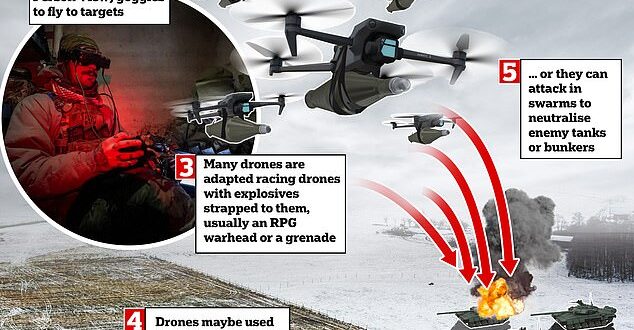On a scorched brown field pitted by blast craters, a lone Russian soldier cowers under the charred remains of his tank, sheltering from a terrifying new threat – one that already has him in its sights.
From the sky above comes the whining buzz that has become the nightmare of Putin’s forces on the front line in Ukraine – that of a tiny suicide drone, no larger than a football but packed with enough explosives to level a house.
The noise sends the helpless soldier into a frenzied panic, as he desperately scrambles round his tank trying to escape, while the kamikaze death machine chases him in a deadly game of cat and mouse – one the Russian loses.
The aerial attacker hits Kremlin fighter with ruthless efficiency, detonating in a flash of orange flame and white smoke, leaving his bloodied body a lifeless wreck, smouldering on the muddy floor.
The brutal encounter – now common place at the front – was filmed by another UAV, with the kamikaze controlled from a bunker miles away by a Ukrainian soldier wearing special goggles that give him a first-person view (FPV) of the carnage.
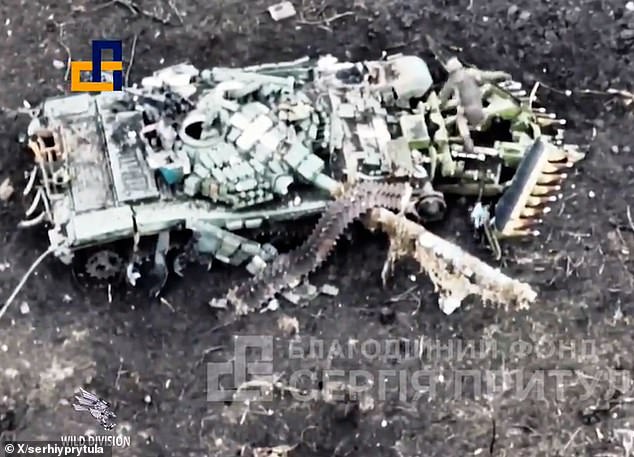
In a hellish and war-torn Ukraine, a Russian soldier is spotted by a suicide down cowering under the main gun of a destroyed tank
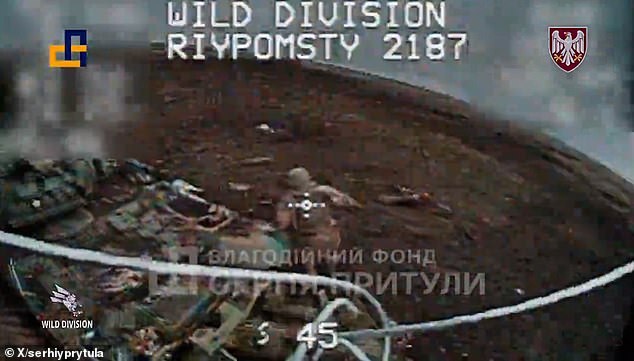
From miles away, a Ukrainian operator wearing specialised goggles that give him a first-person view (FPV), chases the terrified Russian with the drone – which is packed with explosives
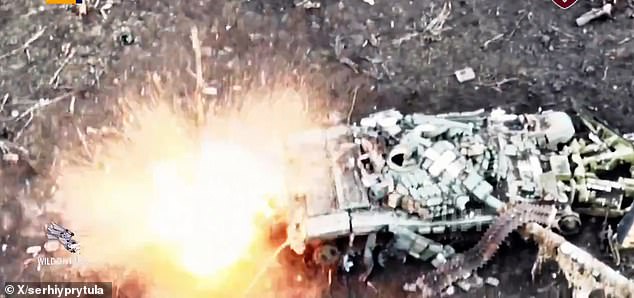
Unable to escape, the helpless Russian is hit by the drone, which explodes in a flash of orange
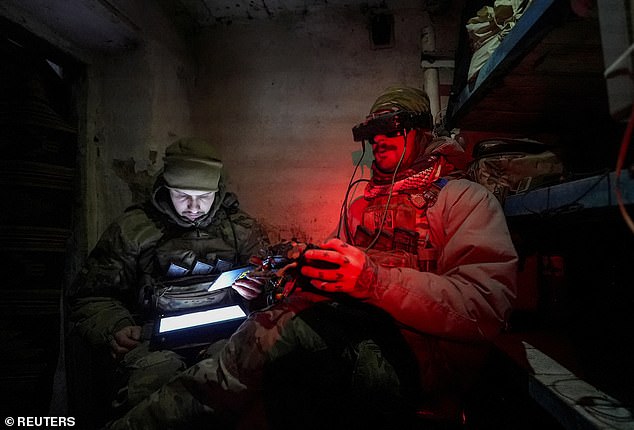
The Ukrainian troops have increasingly been using these ‘FPV’ drones to strike everything from tanks and personnel carriers, to trenches an lone troops
It’s the ugly new dawn in the savage attritional plod of Ukraine’s war, which sees FPV drones swarming the battlefield, pulverising troops on both sides, in a tactic that was almost unheard of a year ago. Now, hundreds of suicide drone missions are flown along the front every day.
The latest killing was carried out by Ukrainians from the ‘Wild Division’ of the 2nd Air Assault Brigade, which has become so lethal operators can fly FPVs into bunkers, through windows and can even hit lone Russians, who they disparagingly call ‘Orcs’.
Grisly footage on social media shows the suicide bots slamming into packed troop transports, blowing them – and the soldiers within – to smithereens, flinging limbs across the battlefield. Others see drones dealing death from above, ambushing troops as they evacuate injured comrades on stretchers.
‘Orc demonstrates great [football] skill… headbutts FPV drone,’ gloats one account callously in a graphic clip on X (formerly Twitter) showing a Russian blown apart by a drone as it detonates on his face.
Both a dark omen to the future robotic warfare and an ingenious invention for the needs of the moment, the rise of the FPV kamikaze drone is reshaping the costs, speed and lethality of war in Ukraine.
It’s allowed drone pilots from both sides to hunt and kill with a scale, accuracy and terrifying efficiency unseen since the start of Russia’s invasion in February 2022.
And their effectiveness has left British military chiefs worried.
‘This little thing we see on the battlefield in Ukraine is in the foothill of where this technology can go, which is a very worrying place… it could become a new weapon of mass destruction,’ warned General Sir Richard Barrons, who once led the UK’s Joint Forces Command.
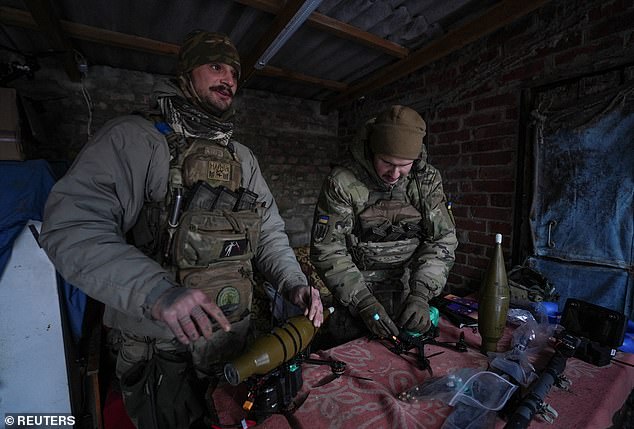
Ukrainian soldiers have struck terror into the hearts of Russian troops, with their suicide drones which are strapped with explosives
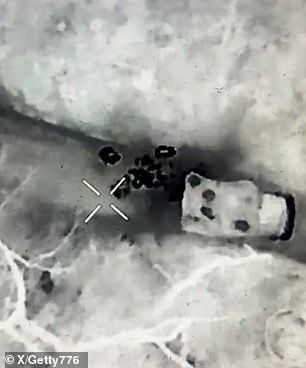
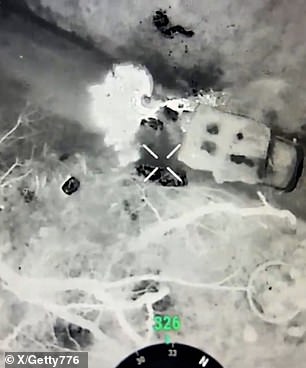
A group of Russian troops were reportedly spotted by a Ukrainian drone team while they were resting by one of their vehicles. Using thermal imaging, the drone swoops in and drops a grenade into the group, with detonates with lethal effect
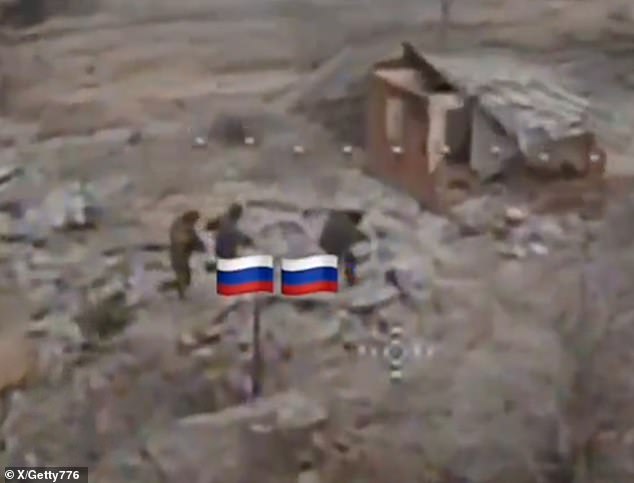
In another video, a group of three soldiers were seen scurrying between wrecked buildings
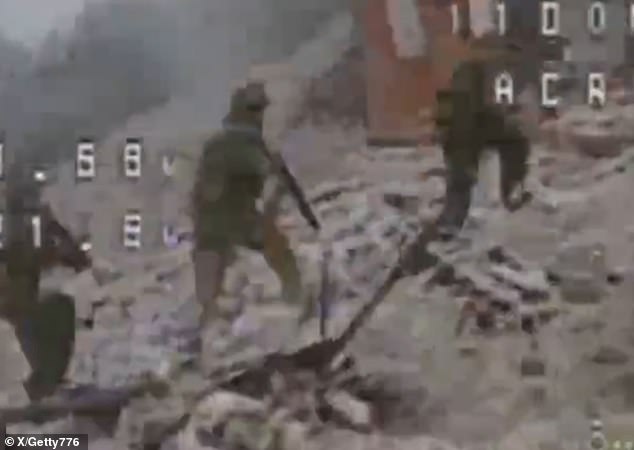
The first-person view of a suicide drone captures the final moments before it detonates next to them all
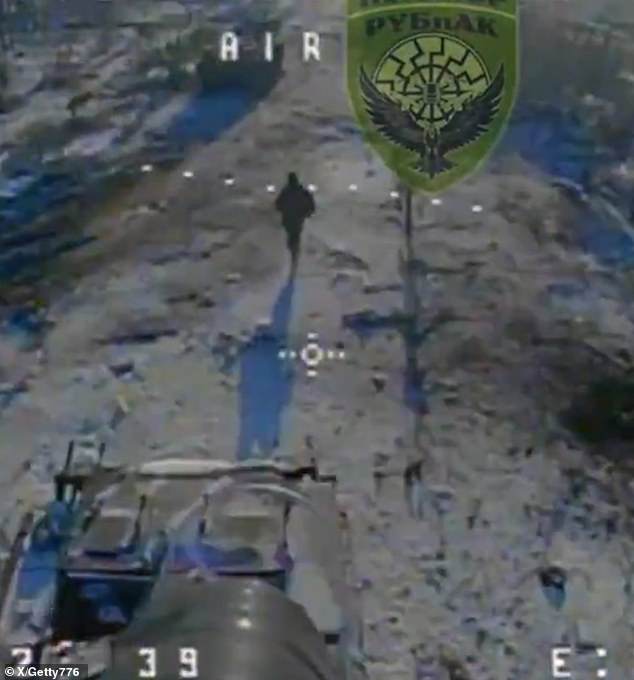
While in this footage, a drone is seen chasing a lone soldier in the icy war-torn wastes of eastern Ukraine
While Major General Charlie Herbert, the former Commander of British Forces in Helmand, warned ‘nowhere is safe on the battlefield’.
‘How different might our campaign in Afghanistan have looked if the Taliban had had drones? They would have wrought havoc on us in our forward operating bases. We’re lucky that they didn’t,’ the retired defence chief added.
‘I have been under shell fire, rocket fire and mortar fire in my military career – they’re all frightening and relatively indiscriminate. But when you have drones buzzing above your head it’s more personal. You know you’re going to be hunted down by one of these things. This adds an extra level to the psychological torture.
‘It’s completely terrifying. Warfare is always an incubator for technology not just military technology. Ukraine is proving an incubator for drone warfare technology. It’s happening fast.
‘This is really frightening where this goes.’
As the war continues to drag its heels, draining ammunition, equipment and manpower, both sides have started to turn to using the FPVs to hold it each other bay while they rearm.
Typically, the drones – which are about £300 a piece – will be used to target high-value assets like tanks and artillery system, worth millions of pounds each. But increasingly, they are being used to hound individual soldiers on the front.
Ukraine has been at the forefront of adopting the technology – with troops waging psychological warfare online, sharing graphic clips of the final moments of a suicide drone as they chase down motorbikes and quads; diving into a party of stretcher bearers; attacking soldiers smoking in trenches or hunting isolated troops as they run for their lives.
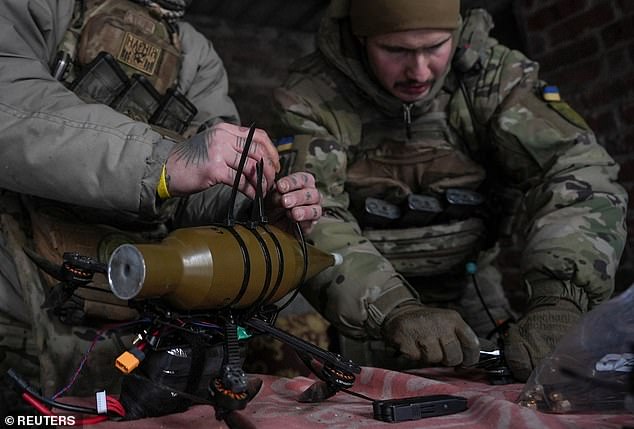
A Ukrainian operator straps an explosive warhead to a drone inside a bunker on the front line
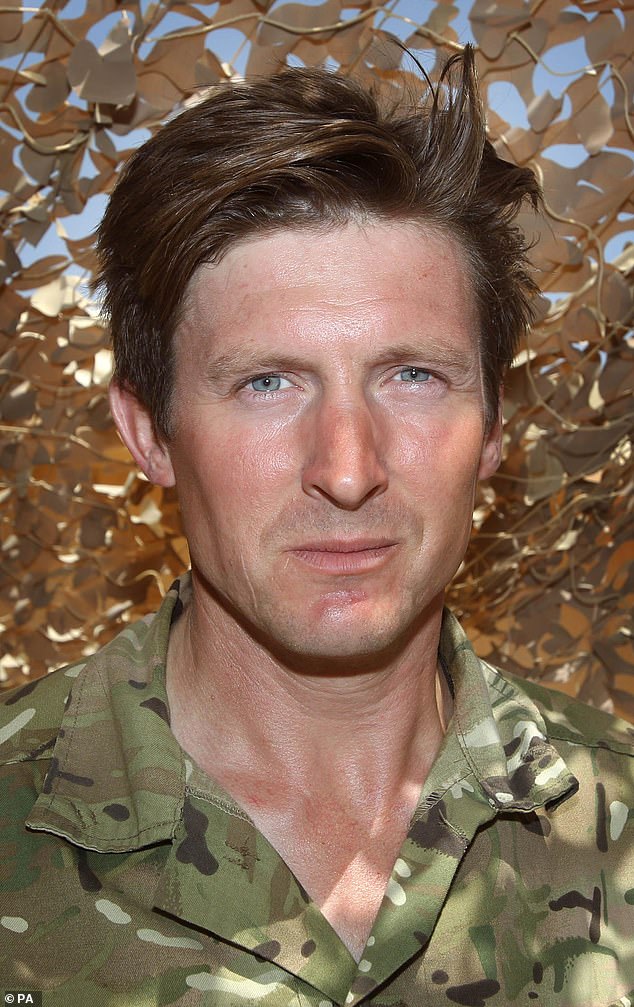
Major General Charlie Herbert, the former Commander of British Forces in Helmand, warned ‘nowhere is safe on the battlefield’
‘We are all human beings, but for me, enemy soldiers are not just a legitimate target and professional target: they are targets that excite me,’ a drone pilot from Ukraine’s 54th Brigade told the Times. ‘Destroying them does not involve moral doubt, it gives me moral satisfaction.’
Although Kyiv was the first to seize the initiative in using the cheap drones, military analysts say Russia now has the upper hand, having reportedly stocked up on large numbers of the flying bots and packing them with sophisticated kit.
The effectiveness of the attack robots has left industry scrambling for ideas on how to counter them. Everything from electronic jammers and disruption guns, to rifles that fire nets have been trialed by various militaries.
In America, Utah-based Fortem Technologies, an airspace security and defence firm, has gone a step further and developed a net-slinging drone interceptor called the DroneHunter F700, which is fully autonomous, radar-guided and powered by artificial intelligence.
But such systems are still few and far between on the battlefield.
And now there are fresh fears that an arms races to overwhelm these developing defences could see the introduction of drone swarms powered by artificial intelligence, which could act without the use of a human operator.
Potentially equipped with facial recognition software, the drones could act loiter above battlefield and kill independently. Tradition electronic warfare defences, which would disrupt communication between drones and human operators, rending them useless, would be ineffective in this case.
General Sir Richard now fears the development is only the start of a terrifying long road which he says could see drones becoming the new weapon of mass destruction – one that could easily be used by terrorists in the future.
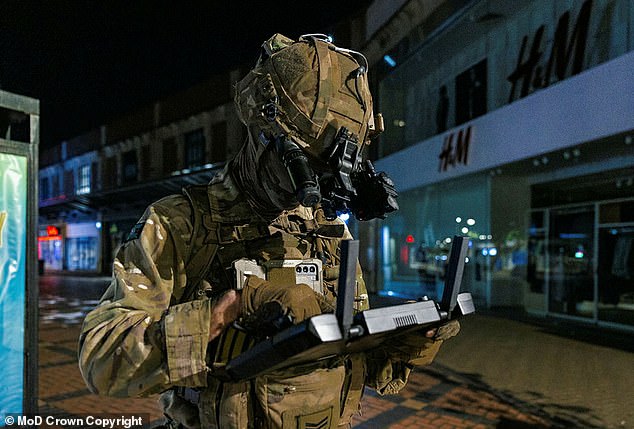
British soldiers are already testing out their own drones. Pictured is a drone pilot from Army’s Experimentation and Trials Group during an exercise in Swindon
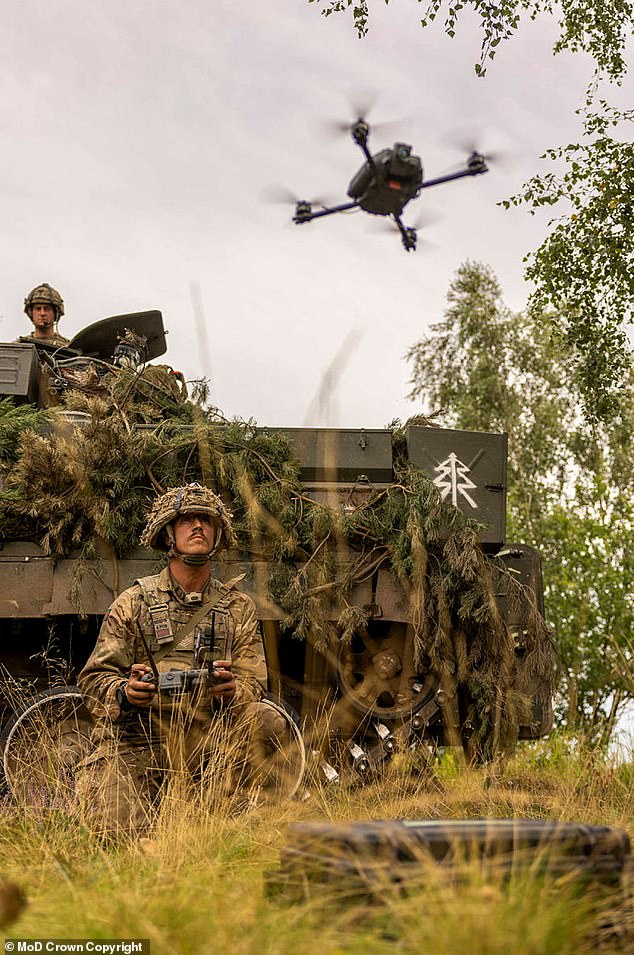
The Army has also taken their drones overseas. Pictured is a recce soldier from 1 Royal Welsh during an exercise in Germany
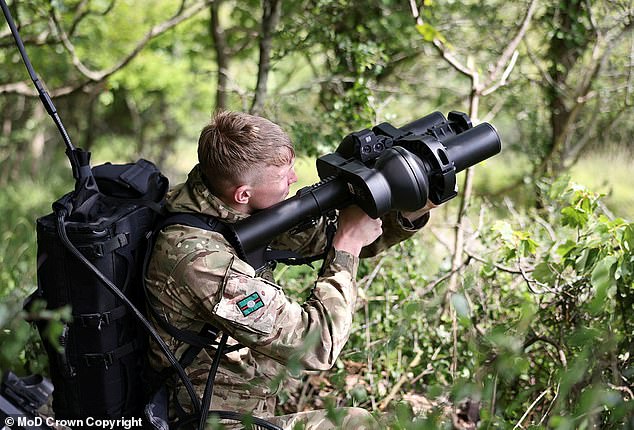
And other soldiers have tested new anti-drone guns like this NightFighter which uses technology to target and disrupt unmanned aerial vehicles (UAVs), rending them useless
‘As the counter measures become more common and cheaper people will look to see how they overwhelm countermeasures by mass. You do this in drones by swarming. This isn’t about sending ones and twos up. It’s about sending hundreds,’ he told MailOnline.
‘Apply that to the battlefield where you deliver a huge swarm which are fitted with facial recognition technology and artificial intelligence and you’re beginning to get to a place where you’re building fleets of drones, connected to data, that allows them to seek out and defeat a target.
‘That can then create a decisive technology which can kill hundreds or people. This could then create a new era of weapons of mass destruction – creating lethal, autonomous weapons systems that can kill humans in an unstoppable way.
‘This little thing we see on the battlefield in Ukraine is in the foothill of where this technology can go, which is a very worrying place… it could become a new weapon of mass destruction.’
‘Doing this is not science fiction – you can do it now,’ he added.
The British Army is already experimenting with drone tech. In the past few years soldiers have been testing everything from tiny reconnaissance drones that can fit in the palm of a soldier’s hand, to larger devices capable of shuttling ammunition of flying out wounded soldiers.
In September, the Army unveiled its latest prototype, a jet-powered drone armed with laser-guided Brimstone missiles.
Called the Hydra 400, British military chiefs say the heavy-lift piece of kit could fit in the back of a truck and would be ready to fly in just six minutes, packing enough punch to knock-out the best tanks in the world.
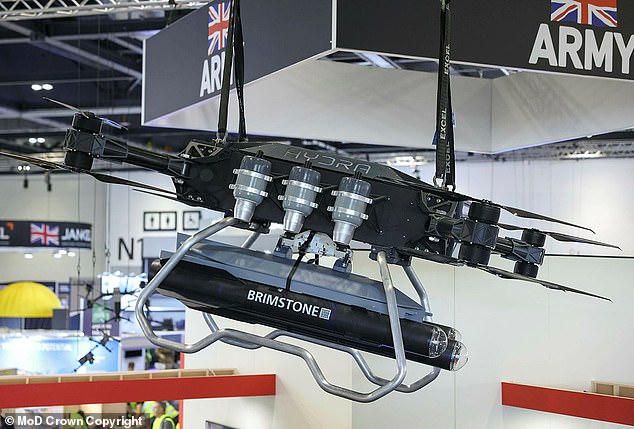
In September, the Army unveiled its latest prototype, the Hydra 400 – a jet-powered drone armed with laser-guided Brimstone missiles
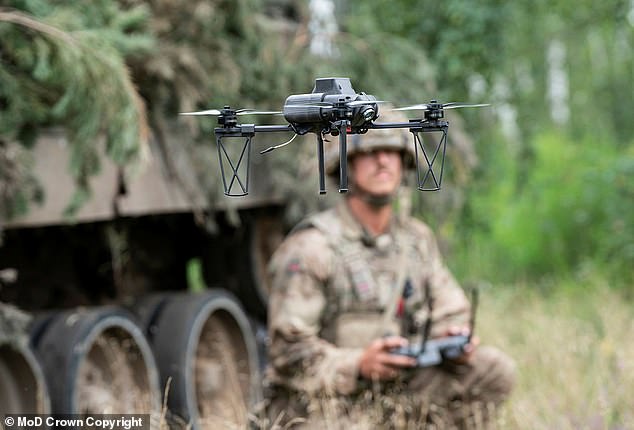
The British military has ramped up its own research into drones following their widespread and effective use in Ukraine
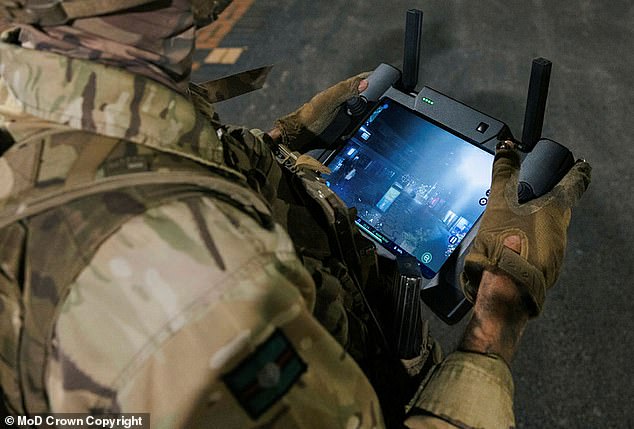
Picture is the tablet screen showing the view from one of the British Army’s test drones
The development is part of the Army’s Warfighting Experiment, which has been running out of Portsmouth Naval Base, in Hampshire.
Among Britain’s arsenal that can take down drones includes the high velocity missile system which uses state-of-the-art lightweight multi-role missile. Specialist gunners from the Royal Artillery and Royal Marines are among those trained to use the kit.
The Ministry of Defence is also rolling out the ‘SMASH Smart Weapon Sight Fire Control System’, a cutting-edge weapon sight, that gives soldiers assistance in wear to shoot to take down an aerial drone.
The ‘SMASH’ sight can recognise a target, track its movements, and maintain a lock on the target giving soldiers the ability to achieve a high probability of a hit against mini-UAVs.
In January, Britain unveiled it’s new ‘Dragon Fire’ laser system, which can destroy everything from drones to hypersonic missiles.
A spokesman for the Ministry of Defence told MailOnline: ‘We currently have a number of highly effective systems, that are able to meet the threat posed by FPV drones.
‘These include systems such as the High Velocity Missile System and the SMASH Smart Weapon Sight, which can track and lock on to drone targets
‘We recognise the importance of the growing threat of FPV drones, and we are continually researching and developing new systems to counter the threats of the future.’
Meanwhile in Ukraine, President Volodymyr Zelensky has vowed to build a million drones this year as Kyiv sought to boost current production levels. ‘We will do everything to make it so. I know that’s how it will be,’ Zelensky said.
Soon Ukrainians may be making kamikaze drones at home too, with digital transformation minister Mykhailo Fedorov this month urging Ukrainians to do their bit for the suicide drone effort by creating their own for the military at home as part of a ‘People’s Drone’ project.
Those joining the effort have been offered a free engineering course to teach themselves how to assemble a 7-inch FPV drone in their houses.
Despite their effect in Ukraine, Maj Gen Herbert said FPV drones were far from a major game-changer.
‘Drones are not a game-changer or revolution in military affairs like the advent of gunpowder or the invention of the tank. But they’re adding to the violence and psychological impact of war,’ he added.
 Unmanned Aerial Vehicle The latest drone news
Unmanned Aerial Vehicle The latest drone news
